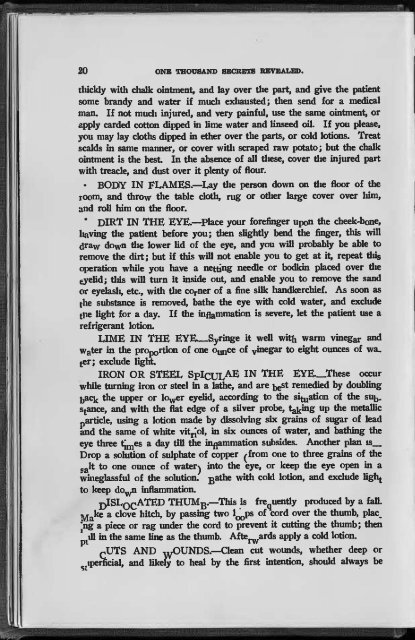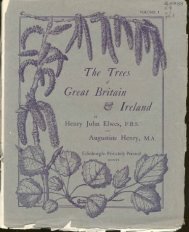You also want an ePaper? Increase the reach of your titles
YUMPU automatically turns print PDFs into web optimized ePapers that Google loves.
20 <strong>ONE</strong> <strong>THOUSAND</strong> <strong>SECRETS</strong> <strong>REVEALED</strong>.<br />
thickly with chalk ointment, and lay over the part, and give the patient<br />
some brandy and water if much exhausted; then send for a medical<br />
man. If not much injured, and very painful, use the same ointment, or<br />
apply carded cotton dipped in lime water and linseed oil. If you please,<br />
you may lay cloths dipped in ether over the parts, or cold lotions. Treat<br />
scalds in same manner, or cover with scraped raw potato; but the chalk<br />
ointment is the best. In the absence of all these, cover the injured part<br />
with treacle, and dust over it plenty of flour.<br />
BODiY IN FLAMES. Lay the person down on the floor of the<br />
room, and throw the table cloth, rug or other large cover over him,<br />
and roll him on the floor.<br />
" DIRT IN THE EYE. Place your forefinger upon the cheek-bone,<br />
having the patient before you; then slightly bend the finger, this will<br />
draw down the lower lid of the eye, and you will probably be able to<br />
remove the dirt; but if this will not enable you to get at it, repeat this<br />
operation while you have a netting needle or bodkin placed over the<br />
eyelid; this will turn it inside out, and enable you to remove the sand<br />
or eyelash, etc., with the corner of a fine silk handkerchief. As soon as<br />
the substance is removed, bathe the eye with cold water, and exclude<br />
the light for a day. If the inflammation is severe, let the patient use a<br />
refrigerant lotion.<br />
LIME IN THE EYE. Syringe it well with warm vinegar and<br />
water in the proportion of one ounce of vinegar to eight ounces of wa<br />
ter; exclude light.<br />
IRON OR STEEL SPICULAE IN THE EYE. These occur<br />
while turning iron or steel in a lathe, and are best remedied by doubling<br />
back the upper or lower eyelid, according to the situation of the sub<br />
stance, and with the flat edge of a silver probe, taking up the metallic<br />
particle, using a lotion made by dissolving six grains of sugar of lead<br />
and the same of white vitriol, in six ounces of water, and bathing the<br />
eye three times a day till the inflammation subsides. Another plan is<br />
Drop a solution of sulphate of copper (from one to three grains of the<br />
salt to one ounce of water) into the eye, or keep the eye open in a<br />
wineglassful of the solution. Bathe with cold lotion, and exclude light<br />
to keep down inflammation.<br />
DISLOCATED THUMB. This is frequently produced by a fall.<br />
Make a clove hitch, by passing two loops of cord over the thumb, plac<br />
ing a piece or rag under the cord to prevent it cutting the thumb; then<br />
pull in the same line as the thumb. Afterwards apply a cold lotion.<br />
CUTS AND WOUNDS. Clean cut wounds, whether deep or<br />
superficial, and likely to heal by the first intention, should always be<br />
MEDICAL DEPARTMENT. 21<br />
washed or cleaned, and at once evenly and smoothly closed by bringing<br />
both edges close together, and securing them in that position by adhesive<br />
plaster. Cut thin strips of sticking plaster, and bring the parts together;<br />
or if large and deep, cut two broad pieces, so as to look like the teeth<br />
of a comb, and place one on each side of the wound, which must be<br />
cleaned previously. These pieces must be arranged so that they will<br />
interlace one another; then, by laying hold of the pieces on the right<br />
side with one hand, and those on the other side with the other hand,<br />
and pulling them from one another, the edges of the wound are brought<br />
together without any difficulty.<br />
Ordinary Cuts are dressed by thin strips, applied by pressing down<br />
the plaster on one side of the wound, and keeping it there and pulling<br />
in the opposite direction; then suddenly depressing the hand when the<br />
edges of the wound are brought together.<br />
CONTUSIONS are best healed by laying a piece of folded lint,<br />
well wetted with extract of lead, or boracic acid, on the part, and, if<br />
there is much pain, placing a hot bran poultice over the dressing, repeat<br />
ing both, if necessary, every two hours. When the injuries are very<br />
severe, lay a cloth over the part, and suspend a basin over it filled with<br />
cold lotion. Put a piece of cotton into the basin, so that it shall al<br />
low the lotion to drop on the cloth, and thus keep it always wet.<br />
HEMORRHAGE, when caused by an artery being divided or torn,<br />
may be known by the blood issuing out of the wound in leaps or jerks,<br />
and being of a bright scarlet color. If a vein is injured, the blood is<br />
darker and flows continuously. To arrest the latter, apply pressure by<br />
means of a compress and bandage. To arrest arterial bleeding, get a<br />
piece of wood (part of a broom handle will do), and tie a piece of tape<br />
to one end of it; then tie a piece of tape loosely over the arm, and pass<br />
the other end of the wood under it; twist the stick round and round<br />
until the tape compresses the arm sufficiently to arrest the bleeding, and<br />
then confine the other end by tying the string around the arm. A com<br />
press made by enfolding a penny piece in several folds of lint or linen<br />
should, however, be first placed under the tape and over the artery. If<br />
the bleeding is very obstinate, and it occurs in the 'arm, place a cork un<br />
derneath the string, on the inside of the fleshy part, where the artery<br />
may be felt beating by anyone, if in the leg, place a cork in the direction<br />
of a line drawn from the inner part of the knee towards the outer part<br />
of the groin. It is an excellent thing to accustom yourself to find out<br />
the position of these arteries, or, indeed, any that are superficial, and to<br />
explain to every person in your house where they are, and how to stop<br />
bleeding. If a stick cannot be got, take a handkerchief, make a cord<br />
bandage of it, and tie a knot in the middle; the knot acts as a compress,













